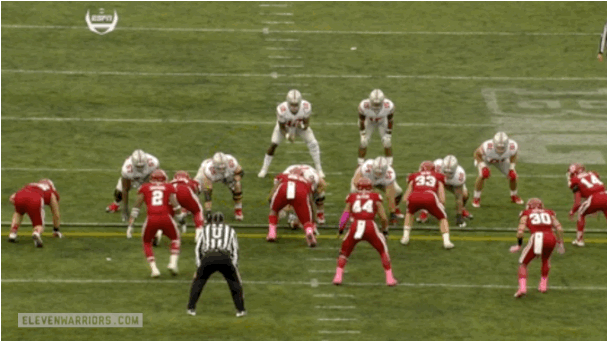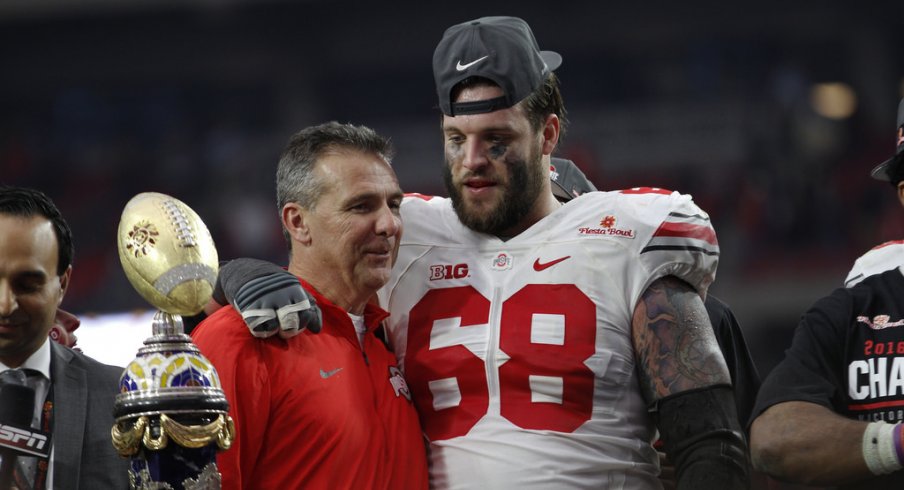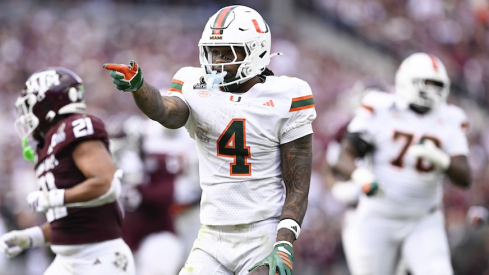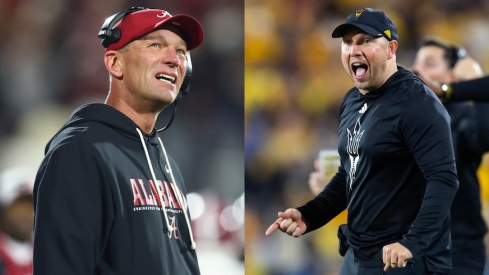"People think that we're this spread team, but we have the same run plays, the same pass pro as they run in the league; we have a West Coast passing game and a pro-style defense."
Those are the words of Urban Meyer in a recent piece on NFL.com, in which the Ohio State head coach is praised for his efforts to prepare a potential-record 15 draft picks in this weekend's 2016 NFL Draft. Undoubtedly, Meyer and his staff deserve praise for identifying, recruiting, and developing the talent that formed the core of the 2014 National Championship team, but some questions have lingered around Meyer's ability to truly prepare his players for the next level.
These questions are usually limited to the offensive side of the ball, as Meyer has produced multiple stars on defense, from pro bowlers like Carlos Dunlap and Joe Haden at Florida to young contributors like Ryan Shazier and Bradley Roby at OSU. Soon-to-be former Buckeyes like Joey Bosa and Darron Lee look poised to join their ranks, with many scouts considering the former to be the top prospect overall on their draft boards.
But Meyer has largely been more involved with his offenses during his coaching career, making the professional success of his former players on that side of the ball a direct reflection of the head man's abilities. Unfortunately, in this regard his track record features fewer successes, with the surprising exception of offensive linemen.
There are countless explanations for the professional successes or failures of those that played for the three-time National Champion, many of which had nothing to do with their college careers. But all too often, critics use the shotgun 'Spread' offense with which Meyer is often credited with developing as a common excuse for why his former troops fail to replicate their success in the NFL.
Is this a fair assessment? Or simply a lazy excuse to explain why some players succeed and others wash out? Let's look at each position group to see if we can understand how Meyer's playbook prepares his players for the rigors of Sunday football.
Offensive Line
As mentioned previously, Meyer's staffs clearly know how to develop talent in the trenches. This group of former players is headlined by the Pouncey twins, Mike and Maurkice, who have been to seven Pro Bowls combined in a relatively short time. But fellow former Gator Marcus Gilbert has been a mainstay at tackle for the Pittsburgh Steelers over the past five seasons. At the same time, former Buckeyes Corey Linsley, Jack Mewhort, and Andrew Norwell have all become reliable starters in only their second seasons, capped off by the latter's appearance in this year's Super Bowl with the Carolina Panthers.
None of that is news for Buckeye fans though, and it still doesn't give us any insight into why they've found professional success. Meyer dropped some hints in the opening quote though, when referring to the run plays included in his game plans.
Unlike most "spread" teams of the previous decade that relied almost exclusively on zone blocking, the Buckeyes execute a number of zone and gap-blocking concepts, replicating the same styles seen by most pro teams. Every NFL playbook includes tight (inside) and stretch (outside) zone blocking, along with Power-O, Counter-Trey, and Buck Sweep gap schemes, and those that read Film Study regularly know that the OSU offense is no different.

These five concepts make up the vast majority of NFL run-blocking schemes, meaning that despite the window dressing of formations and motion often included in their college play-calls, former Buckeye linemen are already very familiar with each concept before they ever attend a rookie minicamp.
Pass protection has been a bit of a different story, however. With the exception of Gilbert, all of Meyer's former troops have played as centers or guards, positions that rarely require them to take on the best opposing pass-rushers.
As the first of many blue-chip tackle prospects to sign with Meyer in Columbus, Taylor Decker looks to break this trend. However, former pro defensive end and current analyst Stephen White believes Decker's success will come from natural ability and desire rather than technique when facing NFL edge rushers.
This unit's failure to protect the quarterback was blamed for the Buckeyes' lone losses in each of the past two seasons, although those claims may have missed the point (which we'll address later). Decker and his line-mates were tasked with building a strong running game as the foundation for OSU game plans, and there is no question they have been well coached in the areas that often lead to victory.
Running Back
After failing to produce many reliable backs at Florida or Utah, Meyer has broken that trend in Columbus. Former Buckeye Carlos Hyde was selected in the second round of the 2014 draft, and has lived up to that billing despite missing half of last season with a foot injury.
Ezekiel Elliott looks to surpass that standing as this year's top prospect at the position, leaving scouts with the impression that his game offers few, if any, holes to be filled at the next level. That is thanks in large part to the aforementioned diverse, pro-style running game in which Elliott has starred over the past two seasons.
Past 'Spread' offense running backs like Steve Slaton, who starred in West Virginia's outside-zone focused offense, found most of their success by turning the corner and getting outside, something that is much harder to do in the NFL. Elliott, however, has developed the vision, patience, and physical style that should translate immediately to any pro offense, thanks to Meyer's play-calling.

But Elliott has been a major part of the Buckeye passing game over the past two years as well, something most college backs in spread offenses can't say. Elliott caught 55 passes as a starter in Columbus, becoming an important safety valve for his quarterbacks both on designed screens and as a check-down on flare routes.

This ability to make something out of nothing in the passing game is extremely valuable in the NFL and, along with his blocking ability, will keep Elliott on the field as an every-down back. Undoubtedly, Meyer's running back recruits have been made aware of how they'll be well-prepared to fill the role of an NFL back countless times by now, and for good reason.
Wide Receiver
Depending on who you ask, Meyer's claim of running a 'west-coast' passing game may not hold water. Disciples of Bill Walsh came to dominate NFL coaching ranks over the past three decades, which has led to countless variations of the original system, so it's true that Meyer's passing game could be considered a modern variant of the philosophy.
At its core, the 'west-coast' philosophy calls looks to stretch the defense horizontally with short throws, and the Buckeyes certainly look to do that regularly. Whether as part of a run-pass option, or simply called to take advantage of soft coverage, Meyer's quarterbacks have often hit outside receivers with short, 'three-step' routes such as hitches and slants.
Devin Smith, Evan Spencer, and most recently Michael Thomas have all been on the receiving end of these throws, with the latter rising up draft boards thanks to his ability to maximize these opportunities.

Though many scouts talk about the limited 'route trees' of college receivers in spread offenses, the patterns OSU wideouts are tasked with running compare quite well with their professional counterparts. Examples of Hitch, Slant, Go, Crossing, and Screen routes are easy to find when watching receivers in Scarlet and Gray, leaving Outs as the only common pattern to be mastered upon their departure.
Based on last year in NFL here are pass routes new WRs will be expected to run: pic.twitter.com/Jjqbeu7RS4
— Neil Hornsby (@PFF_Neil) April 20, 2016
However, Meyer's receivers are often pegged into running specific routes based on their role or skill set. This makes sense for a coach focused on winning games, but doesn't exactly prepare every Buckeye receiver for success on Sundays.
For instance, although Thomas regularly ran hitch and slant routes on the outside, Braxton Miller rarely ran such patterns as a slot receiver. To take advantage of his quickness, Miller was often tasked with running deep 'Go' and crossing routes.
But few college passing games can run a complete NFL route tree, given the limits on practice time and the need to teach fundamental skills first. Given Thomas' progression since stepping on campus, along with that of former Buckeyes like Devin Smith and Corey 'Philly' Brown before him, it's fair to say that the pipeline of Ohio State wideouts to the NFL continues to stay open.
Quarterback
Having said that though, just because his receivers are running some of the same routes as NFL wideouts, doesn't mean Meyer has a true, 'pro-style' passing game. Despite having been an FBS head coach for 14 seasons, the current leader of the Buckeyes has only produced one quarterback that has achieved success at the next level.
Former Utah QB Alex Smith was taken #1 overall in the 2005 draft by the San Francisco 49ers, but took years to develop into the reliable starter he has become today with the Kansas City Chiefs. Cam Newton, perhaps the best player in the league today, spent two seasons holding a clipboard for him in Gainesville, but it's hard to credit Meyer with much of his development, given how little playing time he saw as a Gator.
The man Newton sat behind is of course the player most often associated with Meyer, Tim Tebow, whose NFL success has been varied to say the least. The reason most cited for Tebow's failure to stick on a professional roster is a slow release, but plenty of quarterbacks in the league have excelled despite non-traditional throwing motions.
To be fair, Meyer's sample size over the past decade has been limited. After Tebow, only 2010 Florida starter John Brantley has been eligible to see time in the league, although he quickly washed out of the NFL after a few weeks. None of Meyer's starting Buckeye QBs have declared for the draft, making Cardale Jones' already unique situation that much more so.
Meyer's QBs have often had to carry a heavier physical load, acting as a primary ballcarrier in the running game at every stop. Though he made comments early in the 2015 season that his signal-caller would carry the ball fewer than they had in the past, that philosophy went out the window late in the year when J.T. Barrett would see 15+ rushes in each of the final four games.
As mentioned, college players can only practice so much, meaning that every snap spent on a zone-read is one less that can be spent recognizing coverages and developing a more complex passing game. When the pace between plays is sped up, OSU quarterbacks often rely on signals from the sideline to determine any adjustments before the snap, a responsibility left solely up to the QB in the pro game.
The more often an offense goes no-huddle, the less time is spent by a QB reading a secondary before the snap, meaning they can only have one or two reads on any given passing play, and when the rush is too confusing, Meyer's field generals have struggled. There is simply too much a pro defense can do to confuse a young quarterback that is only making one or two reads on a passing play, leaving a QB in this system unprepared for what is to come on Sundays in this regard.
The counterpoint to this argument lies directly in Tallahassee, Florida, where Jimbo Fisher's pro-style system may well be the most advanced offense at the collegiate level. Yet even though the Seminoles produced three consecutive first-round draft picks at QB, only Jameis Winston appears to be capable of leading an NFL offense (albeit after only one season).
To make up for the fact that his QBs may not receive the same mental training as their counterparts in other programs, the physical ask is certainly on par with any program. Regardless of who has taken snaps for Meyer in Columbus, they've all been tasked with delivering difficult, downfield throws with accuracy.

More than any other position, the jury is still out on whether Meyer's offense is truly the right place to develop future professional quarterbacks. It will be interesting to see how Jones does in the pros after starting 11 career games as a Buckeye, but the true test will come whenever Barrett moves on to the next level.
Barrett enters his third year as a starter this fall, making him a perfect candidate to expound his talents beyond just reading one defender and distributing the ball. Should he develop to the point that he declares for next year's draft, the fourth-year Junior will look to do something no Ohio State QB has done since 1982: become a first-round draft pick.
Despite the gap at QB, there already are Buckeyes at nearly every other position in the league, something few schools can say. Even the vaunted SEC hasn't produced a regular pro starter at the position since Newton left Auburn in 2011.
Though Meyer may have some holes in his pitch when talking to a recruit about their professional prospects, he still has a better track record than most. OSU could move to the top of the list of most players in the NFL from one school if all 15 potential pros make a roster in the fall.
No other school has this same kind of momentum in producing pro players, especially given that the most of the other top producers of such talent have been able to also produce wins on the field. Telling high schoolers that if they join your team they'll win games AND make it to the NFL? That seems like a pretty solid recruiting pitch to me.


